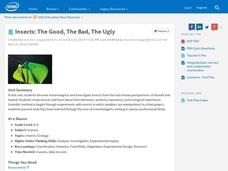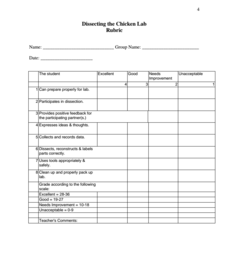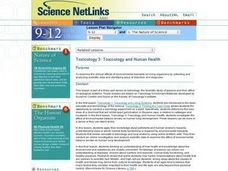Intel
Insects: The Good, The Bad, The Ugly
What would the world be like with no insects? Ponder this question using a research-based STEM unit that encourages scholars to investigate insects from both a beneficial and hazardous perspective. They learn about insect behaviors,...
Curated OER
The Bird Project
Students explore the different characteristics and features of birds. In this life science lesson, students research information on the bird of their choice. They prepare a report and present their findings in class.
Curated OER
Your Amazing Body
Students are introduced to the anatomy of the human body. Using the different systems of the body, they look at how different artists made a picture out of paper. Individually, they make a cut out of various internal organs or bones. ...
Curated OER
X-Ray Eyes
Students observe Australian X-ray paintings for information and to understand the art techniques used. Then they imagine and draw the inner organs of an animal. Students also research the anatomy of the animal to analyze the accuracy of...
Curated OER
Wonderful World of Dinosaurs
Second graders obtain information about the characteristics of diet, locomotion, behavior, habitat, and anatomy of five dinosaurs by observing the Wonderful World of Dinosaurs HyperStudio presentation. They complete a student worksheet.
Curated OER
Genetics
Students explain the difference between dominant and recessive genes, identify what causes differences in the traits of parents and their offspring, and explain how sex is determined. They will also improve their reading and...
Curated OER
Science: Spider Models
First graders create spider models to discover its anatomy. They use construction paper and sequins to make their spiders and use pictures as examples for their models. As an alternative, 1st graders make posters of the spider's parts....
Curated OER
Skeletal Structures
Students relate the location and the function of individual skeletal parts. Students identify and discuss skeletal differences between species. Students identify and define related terminology. Students individually complete a written...
Curated OER
Create a Creature
Students design, build, draw, or bake a creature of their choice and present to the class. They write a paper including the creature's habitat, method of getting energy, their creature as a producer or consumer, predator or prey species...
Curated OER
Your Amazing Body
Students examine the different body systems and how they are interdependent on each other. In this body systems instructional activity students draw the body and its parts.
Curated OER
Toxicology And Human Health
Students examine the clinical effects of environmental toxicants on living organisms by collecting and analyzing scientific data and identifying ways of detection and diagnosis.
Curated OER
Better Body Books, Inc.
Students work in groups of 2-3 people to prepare a book about the human body that is suitable for a 3rd, 4th, or 5th grade student.
Curated OER
Investigation Xylem
Students investigate how water travels up the stem of vascular plants by using food coloring to stain the xylem of a number of different plants. They know the function of leaves, stems, and root at the end of the experiment.
Curated OER
Insect Biodiversity
Students examine biodiversity by conducting comparative biodiversity surveys. They conduct Internet research to identify insects that they have caught in two different habitats, and compare the biodiversity of the two areas.
















